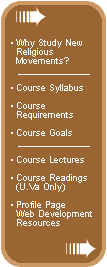
 |
|||||||||||||
Course GoalsAlso available in this site section:
As far as historians and social scientists know, there has never been a human society without some form of religion. Anthropologist Anthony Wallace, a leading social science authority on religions, estimates that in the history of humankind there have been approximately 100,000 religions. New religions are constantly emerging and older religions slip away into oblivion. No new religion emerges fullblown but evolves - sometimes slowly, other times as a rapid pace. New religions take the form of either a sect or a cult and only gradually become recognized as a legitimate faith tradition of the culture in which they reside. |
 |
|||||||||||||||||||||||||||||||
| This course is about
how cults and sects emerge, develop and interact with their host culture.
The sparsity of historical records prohibits a detailed reconstruction of the emergence of
any of the world's great religions. By studying emerging religions, however, we can learn
a lot about how and why religion has persisted. New religions seem always to be
controversial. The "cult controversies" of our day are not very different
from the conflicts of new religions over the course of human history. Studying new
religions from a social science perspective provides a mirror to history and important
insights about the nature and central role of religion in human social organization. The emergence of the Internet has enriched manyfold the amount of material available on religious movements. Further, we can obtain information on groups that are so new that no scholarly literature yet exists (eg. the Toronto Blessing and the Promise Keepers). Not all information available is useful. Indeed, some is misleading and even incorrect. But this serves well the learning goal of assessing the quality and value of information. This class will rely heavily on information posted on the Internet about religious movements. Basic skills required to "surf" the Internet can be learned in a few minutes, and most students who enroll in this course will already have some experience in using the World Wide Web. Developing the skills required to create a web page that can be a useful contribution to the advancement of learning is a challenge, but within the grasp of most students. Ninety percent of the students enrolled in this class over the past three terms have elected to create a web page for a specific group. Students taking the course this term will be using these resource materials. And, hopefully, most will elect to participate in expanding and improving the class home page. This class, then, will pursue the dual objectives of exploring the origins and nature of new religions while simultaneously learning how to creatively use emerging "new media" modern communications technologies. Most of you will begin with little substantive knowledge about new religions; your technology skills will vary from little to extensive knowledge. The only prerequisites to this course are (1) an interest in the subject matter and (2) a willingness to learn about new media like the Internet. If necessary, we will hold special sessions for those who are not skilled in utilizing electronic communication technologies. Learning goals
Conceptual Learning Objectives
Technical Learning Objectives
|
||||||||||||||||||||||||||||||||
Go back to the top of this page.
Copyright © the Religious Movements Page. All Rights Reserved.